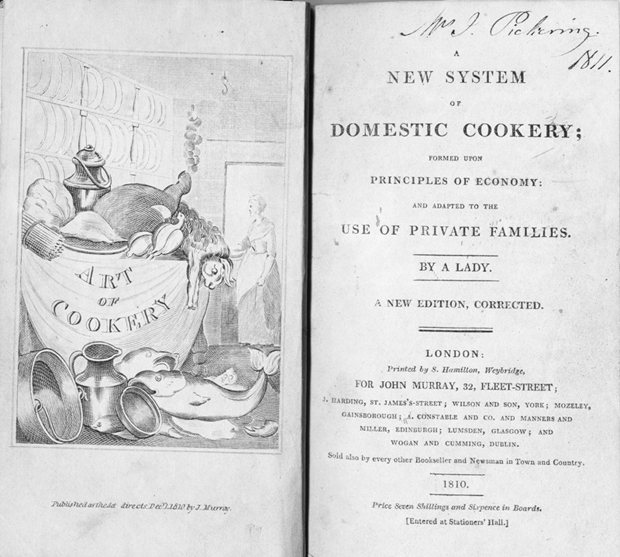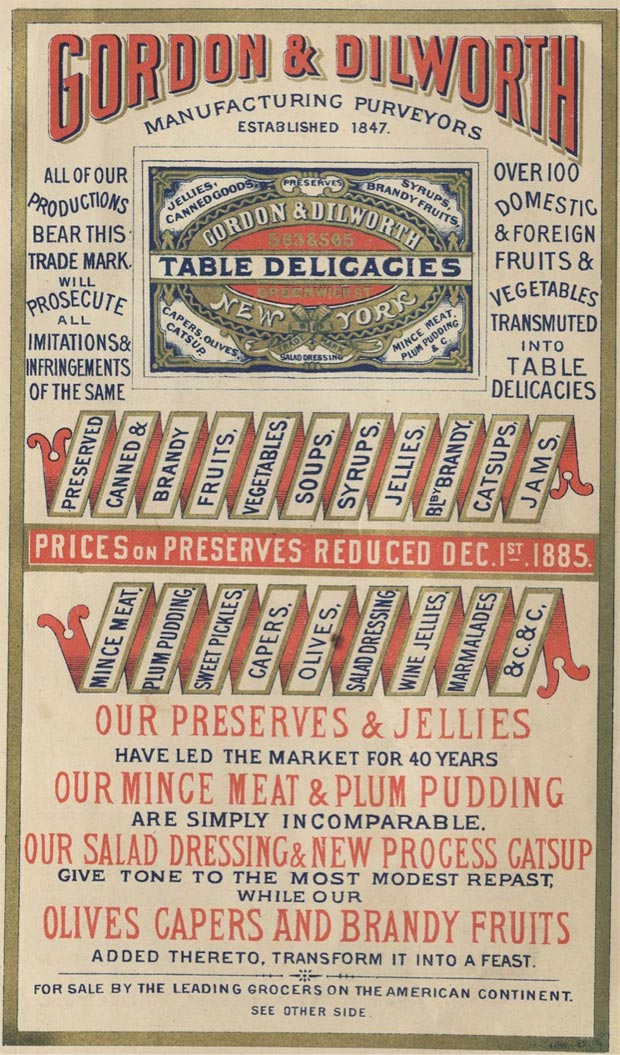The Huntington’s blog takes you behind the scenes for a scholarly view of the collections.
COOKBOOK COLLECTION | To Roast Goose
Posted on Thu., Dec. 13, 2012 by
Another post in a series from the cataloger of the Anne M. Cranston cookbook collection, which consists of approximately 4,400 British and American cookbooks from the 19th and 20th centuries. In this series, Shelley will share fascinating recipes, quotes, kitchen solutions, and anecdotes she has uncovered in the collection.

Cover of the Gold Medal Flour Cookbook (1904). Christmas edition. Minneapolis, Minn.: General Mills, Inc. Reprinted 1970.
“After it is picked, the plugs of the feathers pulled out, and the hairs carefully singed, let it be well washed and dried and a seasoning put in of onion, sage, and pepper and salt. Fasten it tight at the neck and rump, and then roast. Put it first at a distance from the fire, and then by degrees draw it nearer.”
As lovely as that sounds, I believe a slightly more modern recipe might be in order. This portion of a recipe comes from A New System of Domestic Cookery by Mrs. Maria Eliza Ketelby Rundell. This extremely popular cookbook was originally published in 1806. It was reprinted in multiple editions both in England and the United States throughout the 19th century. The Huntington Library has the first edition published in the United States in 1807 and the new corrected edition of 1810. The recipes are fun to read and still contain helpful advice even if you do not have to dress your own goose or light a fire in your oven. For instance, the recipe goes on to tell us that the breast should be covered for a portion of the cooking time, and the goose should be served with a “good gravy” and applesauce.
The traditional Christmas food on my family’s table is somewhat of a mish-mash of cultures, much like my family itself. On Christmas Day we will enjoy everything from ham to homemade tamales to Italian fig cookies called Cuccidata topped with an anise-flavored icing. With all these recipes around me, I started to think about traditional Christmas foods that I haven’t yet experienced.

Frontis and title page of Maria Eliza Ketelby Rundell (1745–1828). A New System of Domestic Cookery; Formed upon Principles of Economy; and Adapted to the Use of Families. A New Edition, Corrected.London: Printed by S. Hamilton, Weybridge, for J. Murray, 32 Fleet-Street, 1810.
I believe that cataloging this cookbook collection should be an adventure. To that end, I have decided to test the recipes in the hopes that you will try them out yourself. This Christmas I will roast a goose or duck and make a traditional Christmas or plum pudding. Yesterday I found out just what I had gotten myself into. Traditional Christmas pudding, while still very popular in the United Kingdom, is not commonplace here and requires an ingredient not normally found on this side of the pond: suet.
I called every butcher I could think of in every specialty store, but no luck. Suet is fat from around the kidneys and loin and has a high melting point that helps give a pudding its sponginess and flavor. Purists would disagree, but there are substitutions. I used grated, unsalted butter. The result is not the same, but still very good. You may also order suet online, as there is a commercial packaged version available. I used a slight variation of this recipe from Mrs. S. T. Rorer’s Philadelphia Cook Book:
English Plum Pudding*
(A Two-Guinea Prize Plum Pudding)
Out of five-hundred recipes sent the Queen, the following was awarded the prize:
1 pound of raisins
1 pound of suet, chopped fine
¾ pound of stale bread crumbs
¼ pound of brown sugar
Grated rind of one lemon
¼ pound of flour
1 pound of currants
½ of a nutmeg, grated
5 eggs
½ pint of brandy
½ pound of minced candied orange-peel
Clean wash and dry the currants. Stone the raisins. Mix all the dry ingredients well together. Beat the eggs and add to them the brandy, then pour them over the dry ingredients, and thoroughly mix. Pack into greased small kettles or moulds (this will make about six pounds), and boil for six hours at the time of making, and six hours when wanted for use. Serve with hard or brandy sauce.
![Yet another Parloa book from the collection: Maria Parloa (1843–1909). Miss Parloa's New Cook Book and Marketing Guide. Boston : Dana Estes and Company, [1880].](/sites/default/files/uploads/2012/12/Goose-Cooked-3.jpg)
Yet another Parloa book from the collection: Maria Parloa (1843–1909). Miss Parloa's New Cook Book and Marketing Guide.Boston : Dana Estes and Company, [1880].
Now what to serve with the roast goose and plum pudding? The Cranston cookbook collection has the answer. There is so much more here than simply a collection of recipes. There are directions on how to run a household, how to furnish and equip a kitchen, how to throw parties, tips on table etiquette, and—most important for my immediate needs—menus for every occasion from the everyday to special banquets. From Miss Parloa’s Kitchen Companion is an intriguing bill of fare for a 19th-century Christmas feast, complete with roast goose and plum pudding. As I conclude with that menu, I sincerely wish you and all your family a Merry Christmas and a wonderful holiday filled with all the wonder and joy the season can bestow.
Raw Oysters.
Consommé à la Royale.
Baked Kennebec Salmon, Lobster sauce.
Boiled Potato Balls, with Parsley Butter.
Roast Goose with Apple Sauce.
Cauliflower. Potato Puffs.
Coffee Granite**
Canvas–back Duck, Orange Sauce
Dressed Celery. French Peas.
Lettuce Salad. Cheese Fingers.
Plum Pudding, Brandy Sauce.
Pistachio Ice Cream.
Orange Sherbet. Cake. Fruit.
Coffee.
* One of the many definitions the Oxford English Dictionary gives for “plum” is “a dried grape or raisin as used for puddings, cakes, etc. This use probably arose from the substitution of raisins for dried plums or prunes as an ingredient in plum-broth, porridge, etc., with retention of the name 'plum' for the substituted article.”
** A granite is an ice dessert, probably used here as a palate cleanser.

Advertisement from Maria Parloa (1843–1909), Miss Parloa's Kitchen Companion: A Guide for All Who Would Be Good Housekeepers.Boston: Estes and Lauriat, 1887.
Here are the books from the Cranston collection that I consulted for this post:
Maria Eliza Ketelby Rundell (1745–1828). A New System of Domestic Cookery; Formed upon Principles of Economy; and Adapted to the Use of Families. A New Edition, Corrected. London : Printed by S. Hamilton, Weybridge, for J. Murray, 32 Fleet-Street, 1810.
S. T. Rorer (1849–1937). Philadelphia Cook Book: A Manual of Home Economics. Philadelphia: Arnold and Company, 1886.
Maria Parloa (1843–1909). Miss Parloa's Kitchen Companion: A Guide for All Who Would Be Good Housekeepers. Boston: Estes and Lauriat, 1887.
Shelley Kresan is a rare book cataloger in The Huntington’s technical services department.